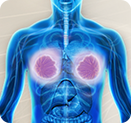What is Breast Cancer? |
|
 |
Breast cancer is cancer originating from breast tissue, most commonly from the inner lining of milk ducts or the lobules that supply the ducts with milk. Cancers originating from ducts are known as ducal carcinomas; those originating from lobules are known as ductal carcinomas. While the overwhelming majority of cases in humans are women, men can also develop breast cancer. |
Understanding Risk Factors for Breast CancerThe primary risk factors for breast cancer are female sex, age, lack of childbearing or breastfeeding, higher hormone levels, race, economic status and dietary iodine deficiency. The genes associated with hereditary breast-ovarian cancer syndromes usually increase the risk slightly or moderately. In more recent years, research has indicated the impact of diet and other behaviors on breast cancer. These additional risk factors include a high-fat diet, alcohol intake, obesity, and environmental factors such as tobacco use, radiation, endocrine disruptors and shiftwork. Symptoms of Breast CancerThe first noticeable symptom of breast cancer is typically a lump that feels different from the rest of the breast tissue. Indications of breast cancer other than a lump may include changes in breast size or shape, skin dimpling, nipple inversion, or spontaneous single-nipple discharge. Pain is not a reliable tool in determining the presence or absence of breast cancer. Inflammatory breast cancer is a particular type of breast cancer which can pose a substantial diagnostic challenge. Symptoms may resemble a breast inflammation and may include itching, pain, swelling, nipple inversion, warmth and redness throughout the breast, as well as an orange-peel texture to the skin, the absence of lump delays detection dangerously. Another reported symptom complex of breast cancer is Paget's disease of the breast. This syndrome presents as eczematoid skin changes such as redness and mild flaking of the nipple skin. As Paget's advances, symptoms may include tingling, itching, increased sensitivity, burning, and pain. There may also be discharge from the nipple. Approximately half of women diagnosed with Paget's also have a lump in the breast. The appearance of a new symptom should be taken seriously by both patients and their doctors, because of the possibility of an underlying breast cancer at almost any age. Diagnosis of Breast CancerMany breast cancers are found on routine mammography. Sometimes the physician will order a breast MRI for a better image a cancer diagnosis will be confirmed with a biopsy. Treatment Options for Breast Cancer at Premier Cancer Center: |
|
|
Most Common Side Effects of Radiation Therapy to the Breast• Reddening of the skin of the treated breast |
|





